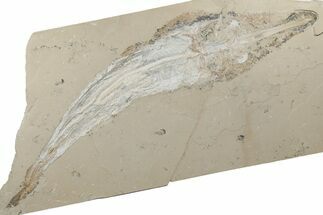This Specimen has been sold.
1.6" Cretaceous Fossil Ammonite - Lebanon
This is a 1.6" wide ammonite from the Cretaceous aged marine deposits of Lebanon. Comes with a display stand.
The discovery of amazingly preserved marine fossils near Hakel, Lebanon dates back many centuries. In fact, they were first mentioned in writing by Herodotus, over 450 years before the birth of Christ. The first scientific work on these localities began in the 1800s: these deposits have been meticulously quarried by several Lebanese families for over a century. We purchase our specimens directly from one of these families.
These deposits represent a warm, shallow sea of the Middle Cretaceous, and have yielded over 70 types of fish and numerous other genera found nowhere else in the world. The preservation on many of these specimens is truly amazing: many examples of soft bodied preservation have been found.
These deposits represent a warm, shallow sea of the Middle Cretaceous, and have yielded over 70 types of fish and numerous other genera found nowhere else in the world. The preservation on many of these specimens is truly amazing: many examples of soft bodied preservation have been found.
About Ammonites
Ammonites were ancient marine cephalopods, similar to today's squids and octopuses, but with a defining feature: their distinctive, tightly coiled spiral shells. These shells, resembling those of modern nautiluses, served as both a protective home and a buoyancy aid, allowing ammonites to navigate the prehistoric seas with ease. First emerging around 240 million years ago in the Triassic Period, ammonites thrived for over 175 million years, adapting through numerous forms and sizes. As predatory creatures, they likely fed on smaller marine organisms, using their tentacles to capture prey. However, their long reign came to an end 65 million years ago at the close of the Cretaceous, coinciding with the mass extinction event that also eliminated the dinosaurs.
Ammonites were ancient marine cephalopods, similar to today's squids and octopuses, but with a defining feature: their distinctive, tightly coiled spiral shells. These shells, resembling those of modern nautiluses, served as both a protective home and a buoyancy aid, allowing ammonites to navigate the prehistoric seas with ease. First emerging around 240 million years ago in the Triassic Period, ammonites thrived for over 175 million years, adapting through numerous forms and sizes. As predatory creatures, they likely fed on smaller marine organisms, using their tentacles to capture prey. However, their long reign came to an end 65 million years ago at the close of the Cretaceous, coinciding with the mass extinction event that also eliminated the dinosaurs.
SPECIES
Unidentified Ammonite
LOCATION
Hjoula, Byblos, Lebanon
FORMATION
Sannine Formation
SIZE
1.6" wide on 3.9 x 3.4" limestone
CATEGORY
ITEM
#162839
We guarantee the authenticity of all of our specimens.
 Reviews
Reviews













